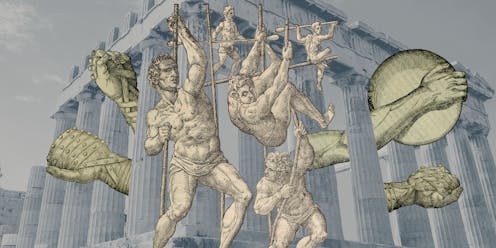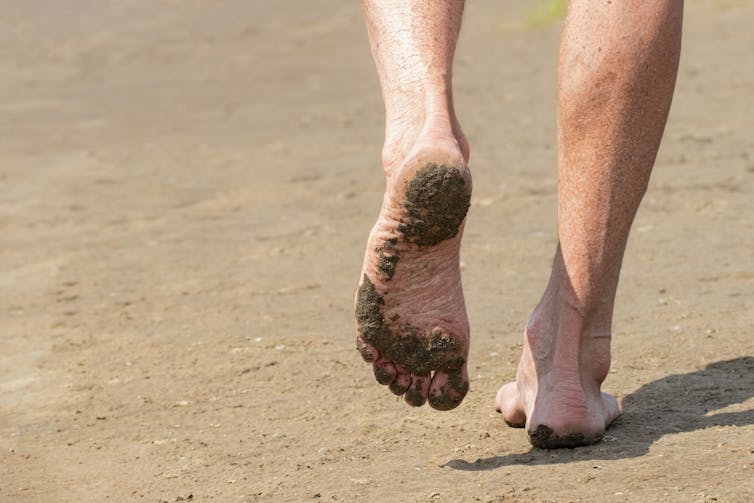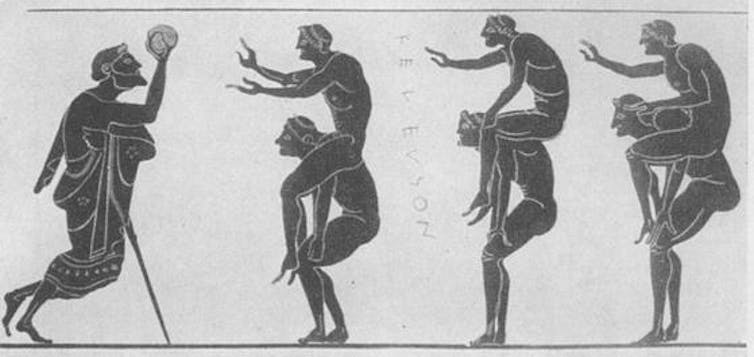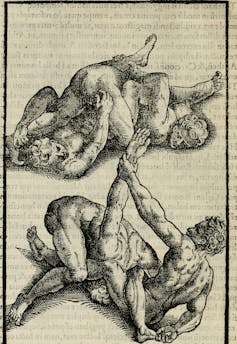
According to the World Obesity Atlas, 42% of the global population will be overweight or obese in 2025. Lack of physical activity is one of the primary causes. Experts regard this as a serious health problem and in Greco-Roman times, too, doctors thought being overweight was bad for one’s health.
The physician Rufus of Ephesus (active in the 1st and 2nd centuries AD) wrote a book called On the Slimming of Fat People. Fat people, he suggested:
cannot endure overexertion, hunger, and indigestion, and have discomfort from them and become gravely ill.
Many Greek and Roman doctors recommended people should lose weight by running and eating only one meal a day. But if you want to know what most people in Greco-Roman times thought about the relationship between physical exercise and health, the best source of information is Girolamo Mercuriale’s On the Art of Physical Exercise.
Published to acclaim in 1569, and illustrated with drawings of the exercises by the artist Pirro Ligorio, Mercuriale’s book was reprinted several times during his lifetime. In 2008, a luxury, 1,000-page edition with an English translation of the original Latin text appeared to mark the Beijing Olympics.

The author
Mercuriale was born in 1530 in Forlì, Italy, and studied medicine and philosophy. In the early 1560s he became the personal physician of Cardinal Farnese, grandson of Pope Paul III. In this period Mercuriale, who was keenly aware of the different attitudes to health and fitness in antiquity and in his own times, wrote On the Art of Physical Exercise.
As he saw it, Greco-Roman doctors had set great value on physical exercise as part of a healthy life. By contrast, doctors in his own time cared little for it.

In his view, many people in his time lived idly and neglected their physical health, which could be improved by doing more exercise.
In antiquity people had exercised at public gymnasia (the equivalent of modern gyms) or, if rich, sometimes at private gymnasia at their houses. People also exercised in nature.
Interestingly, like many ancient doctors, Mercuriale believed being a professional athlete was detrimental to one’s health as it demanded an excessive, unbalanced lifestyle. Ancient athletes had to eat a strict diet, and often tore muscles or injured joints because of overtraining.
Walking
One of the exercises favoured by Mercuriale and his ancient sources was walking. He writes:
The ancients thought so highly of walking that both in private exercise halls and in gymnasia and beyond there was nothing to which they devoted greater attention or zeal than to building places suitable for walking.
People in Greco-Roman times exercised by walking in large public porticoes, or in open air walking tracks, or in underground walking halls (designed for use in bad weather, like heatwaves or storms).
Some ancient doctors thought walking on a course that went up and down through hills was better for health than a flat course, since it involved a variety of bodily movements. Others debated whether it was better to walk on paved roads or on dirt tracks or on sand.
Even the Roman emperor Augustus, who lived from 63 BC-14 AD, exercised by walking on sand. As Mercuriale writes:
When walks are taken on sand, and especially on deep sand, then they are very powerful in hardening and strengthening every part of the body. That is why Augustus, since he did not enjoy good health with his hip and his left thigh and leg (he often limped on that side), used to strengthen them by walks of this kind.

Ball games
Another type of exercise favoured by the ancients was ball games.
There were many kinds of ball games in antiquity including one called the “Episcyrus”, a kind of handball. Mercuriale describes this game thus, drawing on an account by the 2nd-century AD Roman author Julius Pollux:
Equal numbers of players are sorted into two teams, then a middle line is drawn, which is called “scyrus”, and a ball is put out on it. Then they compete for it, in order to hit it between two lines drawn behind each of the contending teams, which are called goals. Obviously, those who succeeded in doing so first were the winners. When the players were occupied in catching the ball, throwing it back, dodging, chasing, loudly cheering each other, and encouraging each other, both players and spectators were likely to be overcome with delight.

Some ancient doctors thought ball games like this were the best kind of exercise, because they were good for both the body (through physical movement) and the soul (through teamwork and camaraderie).
The Greek physician Antyllus (2nd century AD) said ball games make the flesh solid, giving great strength to the arms, the back, the sides, the rib cage, and the legs. Antyllus regularly prescribed ball games for his patients.
Other exercises
Common favourites at the gym were running, wrestling, weightlifting, rope-climbing, and boxing (either with a partner or with a punching bag filled with sand or grain, suspended from the ceiling).

The ancients also played a form of martial arts (combat sports), which involved dressing up in armour and engaging in mock fights or wrestling.
Such sports, wrote Mercuriale, were carried out “with imitation weapons which do not strike a person heavily or cut him”. Or, alternatively, they were performed “against a column or a pole, or even against a shadow”.
Swimming was extremely popular – in the sea or in pools – and held in such high esteem, writes Mercuriale, “that children were taught the art of swimming just as they were taught the basics of literacy”.
The doctor Antyllus said people swimming for exercise should “receive first a moderate massage and be warmed up by the friction on the body, and then immediately plunge into the water”.

Greco-Roman doctors prescribed physical exercises of all these kinds to their patients. An example of this is the case of the athlete Laomedon of Orchomenus, who lived during or before the 2nd century AD.
Laomedon suffered from a condition of the spleen (ancient sources do not explain what his problem was), and was advised by his doctors to take up long-distance running. Having done this for some years, he recovered. He also became one of the best long-distance runners of his time, competing at the Olympic Games.
A book for all times?
The advice given in the book is directed at everyone, men and women, young and old, healthy and sick.
In a dedication at the start, Mercuriale writes of his hope that his patron, Cardinal Farnese, will learn how to live more healthily and take better care of his body by reading the work:
It remains for you, following the example of the ancients, to exercise your own body so widely that you not only achieve the long life that heaven promises you and your nature suggests, but also, if possible, may extend it further.
It’s not known whether Mercuriale practised what he preached and followed his own advice, or if Farnese took up his recommendations.
Farnese died of apoplexy in 1589, 20 years after the above words were written.
Mercuriale married in 1571 and he and his wife Francesca had five children. He died in 1606 in his native town of Forlì from problems caused by kidney stones.
He had written several other large books on medicine and the history of medicine, though none became as famous or as influential as this one.
Konstantine Panegyres does not work for, consult, own shares in or receive funding from any company or organisation that would benefit from this article, and has disclosed no relevant affiliations beyond their academic appointment.
This article was originally published on The Conversation. Read the original article.







